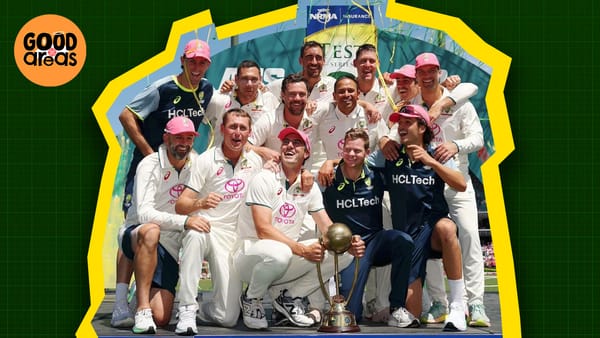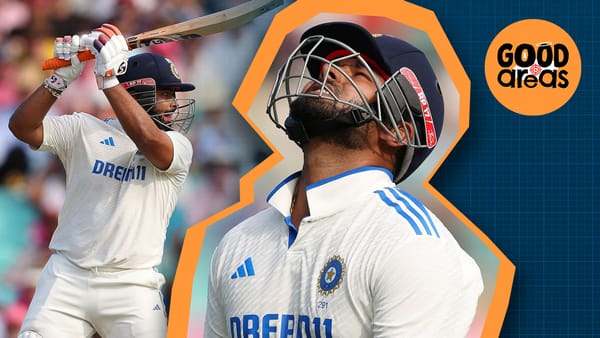Curtis Campher: The little dog with the big bark
How a South African sledged himself into the Irish team and then made a Test hundred in Sri Lanka.
Curtis Campher became an Ireland player by sledging and slogging the Irish team.
They loved his cricket skills, but more than that, they loved how he played his game.
So far he has been pretty good for them. He took four wickets in four balls in a World Cup. He got them to the second round of the World Cup by destroying their arch nemesis Scotland. Now he has a Test hundred in Sri Lanka.
And all this despite not being technically very good with the bat or ball. And that is not me saying that - although it is also me - this is what he said to the Irish Times a few years back, “I have never been the most technically correct batter or bowler.”
What Campher does is try really hard. If you are old enough to remember, he is a bit like the player James Hopes. Who - to misquote Peter Roebuck - was the kind of player you see in a parking game and think, he’s good, but this is his level. Then you see him at grade cricket, and you think, decent, but he won’t go further. Then at Shield level you think, handy guy, but this is it. But somehow, Hopes would end up playing nearly 100 times for Australia as a consistently sloggy hitter and a hard-to-get-away medium pacer.
Campher is from that cloth. He looks more like a club cricketer than an international. You feel at any moment he’s going to be found out. That his medium-fast hustling style will get hit out of existence. That his batting will eventually fall apart under top-level scrutiny.
So far that hasn’t happened. He has actually grown at the international level. His bowling is the weaker skill. But he tried everything he can, which often ends up in lots of wickets in clumps. He can still go for runs, as he has no massive elite bowling skill. But as a fifth option, or even a sixth at times, he is an above-average talent.
Ofcourse for that to work, he has to make runs. And he has. Not enough to be a specialist, but enough to moonlight as number six, and be a decent option at number seven. With Lorcan Tucker’s ascension meaning he can bat pretty much anywhere he wants, it means that Campher can take the number seven spot. That works perfectly as it allows him to attack, and not worry as much about the huge run tally.
That is ideal. Because as much as he has impressed, Campher is still more of a bits-and-pieces player. For many teams that wouldn’t work. But for Ireland, it is probably almost a necessity. But like the best high-performing bits and pieces players, Campher’s performances often come at very important times.
Like in his first World Cup game where he took those four wickets in four balls. It gifted Ireland a game in an over that might have been a tough game otherwise. It was their only win in the tournament.
And then after he was realistic to talk about how fortunate he was in taking them. This could have been the greatest moment he ever had in cricket, and he was honest enough to say that there was luck in it.
What isn’t talked about as much is in the must-win game against Namibia, Campher took Ireland’s only two wickets. This was more like his normal bowling, just getting mishits through to fielders in the ring. Proper medium-pace wickets.
What did he do in the next World Cup? With Ireland losing an elimination game to Scotland, and one foot out of the tournament, he attacked. Chasing 177, they were 61-4 after ten overs. That is when Dockrell joined Curtis Campher. While Dockrell helped, it was Campher’s big hits that started and ended it. 72 from 32.
At this point in his career, he had played six World Cup games and won two of them on his own.
That is not what you expect from a bits-and-pieces club cricket-looking guy.
But in his third Test, he added a hundred in Sri Lanka. Now the Galle wicket does appear to be a pancake. However, a young number seven raised in Jo’Burg and learning his professional trade in Ireland is not really who you expect to play a patient structured innings against Sri Lanka’s many spinners and some canny quicks. (For what it is worth, his record against spin is pretty good. And he credits some of that to how much hockey he played as a kid.)
At every turn, he has outperformed what others saw as his limit. Part of that is just him thrusting himself in every contest. You watch him on the boundary and it is clear that not only can he field, that he is desperate to touch every ball. And his bowling and batting have that same energy. But I don’t just want to write him off as someone who tries very hard, though that is also clearly true.
He is smart too. In one of my old videos, I talked about the zombie ball situation that has been created in limited-overs cricket. But while Kagiso Rabada should not have been run out by this, the reason he was is that Campher was so quickly onto the fact that it may be a no-ball.
The other thing that defines him is that he is a professional. You can see that he can bat, bowl and field. But also the preparation he puts into his cricket. That isn’t surprising, he comes from a family of athletes. His father played golf professionally in the US.
Also, like most stories involving South African cricket players, there is a school involved too. He went to St Stithian’s, the same school as Rabada. (Which also makes that run out funnier from before).
And yes, Campher is South African born and raised. But he also always possessed an Irish passport through his grandmother well before it was convenient for cricket. But the interesting thing is how Ireland found out about it and him.

It all started in this game. A warm-up for Ireland ahead of the 2019 World Cup qualifiers. Campher was representing a combined team. This was about as low-stakes cricket as you could get. A warm-up against whoever was available for a qualifying event.
That was 15 Feb 2018. Two and a bit years later he made his debut for Ireland and made a 50 against England. And then another one next game as well.

But the actual small-town game on a Uni campus in South Africa is the most interesting. Because it was this game that alerted Ireland to the existence of Campher. When he took the wicket of Andy Balbirnie, that was the first time he entered the expanded Irish cricket universe. And after the Easterns and Northerns coach told Graham Ford that Campher had an Irish passport.
But on the field, the Irish players already knew. Because in between a bit of sledging from Niall O’Brien, which Campher was happy to return, he told the ageing batter that he had an Irish passport. Now if he just took the wicket of Balbirnie, that might have been it. Remember, Ireland has a lot of medium-paced bowlers around, that is not something they struggle for.
They probably take a look at him anyway, but remember, he is not that impressive. He is short, not that fast and doesn’t have the most sound technique. It is possible that Ireland weren’t excited by him.

But after the Balbirnie wicket, Campher went out with the bat and smashed the Irish everywhere. including five sixes in his 49 runs against what was a full-strength Ireland attack. There was no doubt he had their attention. And so the former South African Under 19 player picked up a different shade of green.
Campher was never going to have a long career for South Africa if he got in at all. He’s a short, slow bowling, limited batter who tries very hard. And with all the fight, smarts and professionalism in the world, he was going to struggle to get a spot. But in Ireland, he was perfect.
It wasn’t just the three-tool player he was, it was who he was. Someone who had that Jo’Burg dog in him and would fight back.
When Niall O’Brien went at Campher, it would have been easy for the young guy to shut up. He was just a rep player against an Irish cricket legend. But Campher doesn’t see things like that. He fought O’Brien because that is what he does.
That is what his entire career is. And now the bits and pieces with the bad technique has an overseas Test hundred. This is one for the little dog with the big bark.




